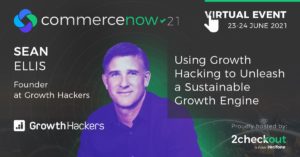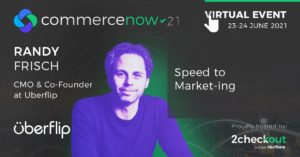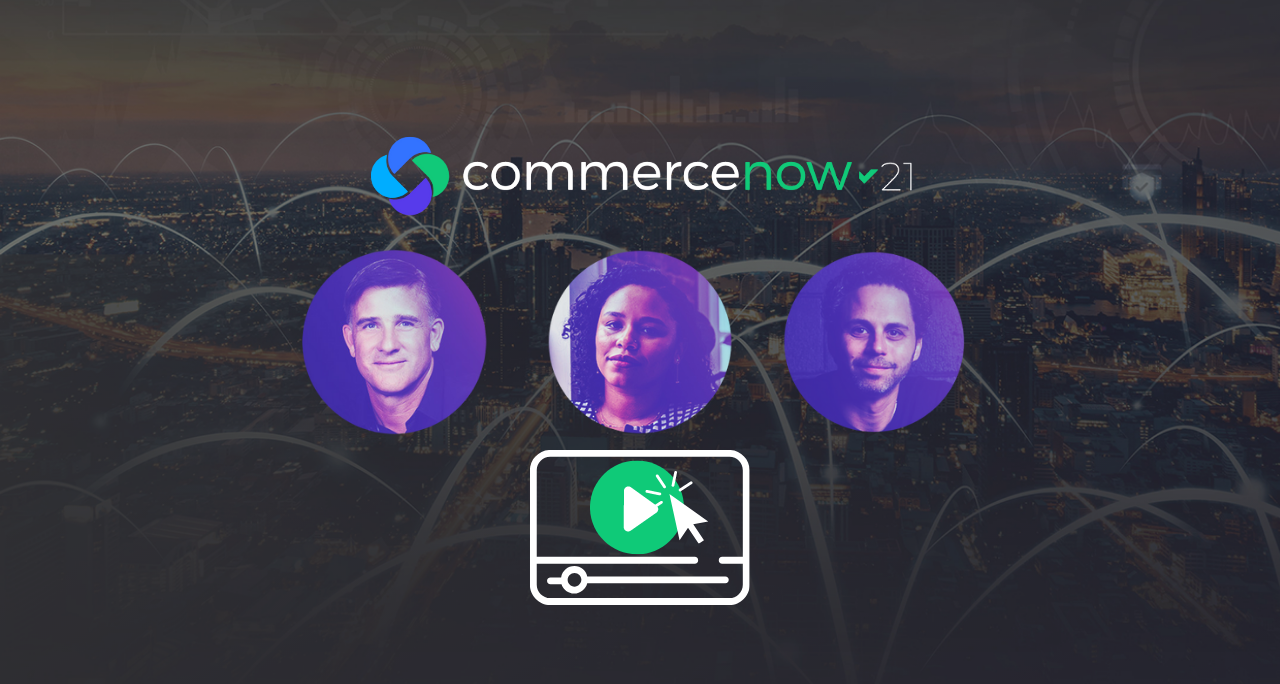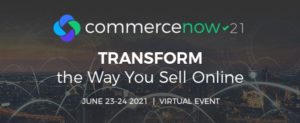The SaaS space is full of opportunity…but it’s also full of competition, similar to online retail. Companies looking to gain a long-term foothold in this lucrative space need to grow quickly to corner the market. The growth hacking process might seem challenging, but with the right knowledge base, developing a winning strategy has never been easier.
As part of our recent CommerceNow’21 digital commerce virtual event, we spoke to top industry thought leaders who each came up with some tips and insights for 2021 (and beyond). Check them out below!
Sean Ellis, founder, and CEO of Qualaroo and GrowthHackers, channeled his extensive experience with early-stage start-up growth into the Using Growth Hacking to Unleash a Sustainable Growth Engine presentation.

With years of experience raising capital for early-stage start-ups, Sean Ellis’ resume speaks for itself – prior to launching two successful startups of his own, he helped multiple companies reach billion-dollar-plus valuations and coined the term “Growth Hacking” in the process. During his presentation, Sean discussed a number of key strategies that he used to take companies from customer zero to an IPO filing.
The first step to success? Understanding, isolating, and measuring your unique value. There are two key ways to do this:
- Analytics: Taking a deep dive into the behavior of your most engaged users provides valuable insights into how they are using your product/s and why.
- Surveys: If you don’t have enough analytical data or want to supplement your research, Sean recommends reaching out directly to these users via surveys.
In either case, the goal is to identify your “value footprint” in order to increase it. Sean refers to this as a company’s North Star metric. Too often, growing businesses focus on increasing acquisitions rather than increasing value – in most cases, 1,000 casual users that don’t interact with your product regularly are less valuable than 100 dedicated users that do.
For profitable companies like Slack and Facebook, daily active users were key to early growth.
It’s interesting to note that successful B2B and B2C companies shared a similar focus on daily active users. The reason? Their unique value metric, or North Star metric, was (and is) the same – both platforms are collaboration tools that focus on connecting people. In both cases, revenue and total user base were less effective growth measurement tools than daily active users.
The main takeaway: Identifying your North Star makes sustainable growth easier, faster, and more efficient to achieve.
Once you identify your value footprint, you can then experiment with unique ways of delivering long-term value to your key users and hack your way to sustainable growth.
Want more practical growth hacking examples?
Check out Sean’s full presentation here – he’s got case studies from Amazon, DropBox, and more.
Asia Orangio, CEO and founder of Demand Maven, broke down some of her growth strategies with the How to Uncover Your Best Growth Opportunities presentation.

As the founder of a successful SaaS growth marketing consultancy group, Asia Orangio has helped countless startups overcome early hurdles and roadblocks on route to sustainable growth. Often, we are our own worst enemy when it comes to growth – in her insightful presentation on uncovering opportunities, Asia highlights some common success gaps and how to identify them.
Growth Hacking 101: Get out of your own way!
In Asia’s experience, early-stage SaaS companies have a tendency to rob their growth and steal from their own future. Essentially, instead of looking for new opportunities in times of stress, our reptilian brains focus on a limited number of metrics. For example, during a slow month, we might focus exclusively on lagging indicators instead of leading ones. As a result, KPIs might be overshadowing potential growth opportunities.
Want to promote sustainable growth? Identify (and fill) gaps in your customer’s journey.
You can’t grow without expanding your customer base or increasing the value you provide to each customer. It’s obvious but it’s true. In some cases, this involves turning one customer into five. In others, it might involve upselling your service or increasing the lifetime value provided.
Asia’s three-pronged approach to accomplishing this:
- Identify the context in which customers buy
When a customer purchases a product or service, they are doing so because they have a job or task to complete. Essentially, they are “hiring” the product. As a business owner or growth marketer, your job is to make this easy for them.
- Map out the customer journey from start to finish
Understanding what your customers want to accomplish with your product or service is important. Understanding how they are pursuing this, and where there is friction in the process, is every bit as valuable to your growth strategy.
- Locate gaps and operationalize around them
If you know what your customers want and can analyze how they are currently obtaining it, you will be able to identify new opportunities that don’t show up when tracking revenue or total users.
By operationalizing around customer research, studies show that companies:
- Increase marketing ROI by 54%
- Sales cycle = 18 times faster
- 56% boost in cross-sell/upsell revenue
Asia’s favorite stat: teams that do at least 10 interviews per month see a two to three times faster growth rate than teams that don’t.
Want more customer research growth hacks?
Watch the full video of Asia’s presentation here.
Randy Frisch, CMO and co-founder of Uberflip, applied his extensive experience with customer-oriented marketing to a content-rich session covering Speed to Market-ing.

With years of high-level experience in both management and marketing, Randy Frisch knows what it takes to connect with customers and turn their attention into sustainable growth. He has a passion for walking customers through the entire journey and increasing funnel velocity by identifying the right scope, controls, and technology. He also loves a good analogy.
View speed to market through the lens of a supermarket or grocery store.
Customers travel from aisle to aisle, filling their carts with items. In the process, they are faced with choices.
- Do I want product X or product Y? Do I value cost-effectiveness over quality?
- Do I need help from an employee, or should I solve issues on my own?
- Do I want to line up for a cashier or do I trust myself at the automated checkout?
Today, an increasing number of customers in the grocery store (and customers in the digital space) are opting for independence, making speed to market more important than ever. Customers value control over their purchasing decisions. As marketers, it is our job to guide them towards making the right choice.
In the grocery store, everything has a fixed, physical location. You can attempt to lure customers with flashy packaging, discount coupons, and in-store advertisements but customers will all be exposed to the same items.
In the digital space, things work a bit differently:
Netflix highlights new shows and movies, but the specific content shown varies based on specific user interests. Amazon does the same thing with eCommerce. Spotify does it with music. The list goes on.
Contrast that with start-ups who provide content in chronological or alphabetical order. Users are being asked to make a choice, but not given any direction. It’s overwhelming and inefficient.
Speed to market + personalized content = satisfied customers.
Technology enables us to do a ton of things that were formerly impossible, but the biggest advantage is the ability to put personalized content right at our buyers’ fingertips. Unfortunately, there’s often a disconnect between how marketers and customers view personalization.
Personalization is not simply firing off generic emails with a customer’s name attached – it’s creating enjoyable experiences that fulfill a customer’s goals.
Randy’s secret to success? Combining speed with relevance to give your customers what they want when they want it.
Check out the rest of Randy’s presentation here for some additional real-world examples and practical insights on how to do personalization right.
Want more growth hacking tips? We’ve got you covered.
Unlock exclusive content from Sean, Asia, Randy, and a host of other growth hacking experts – watch the full Commerce Now 2021 event replay and transform the way you sell online.






